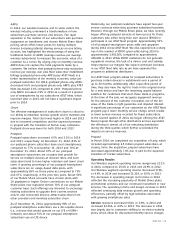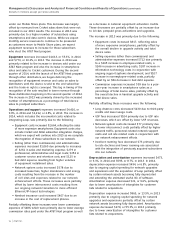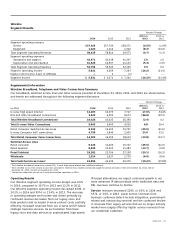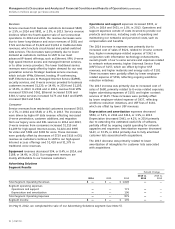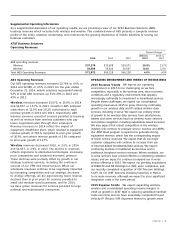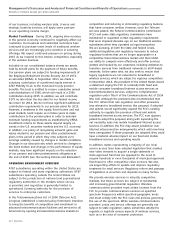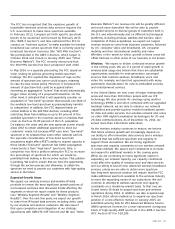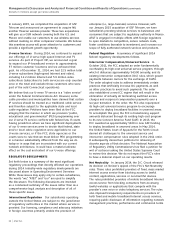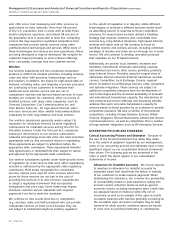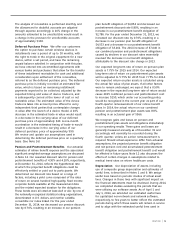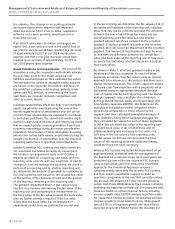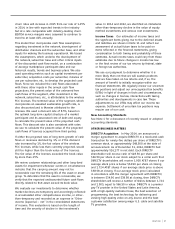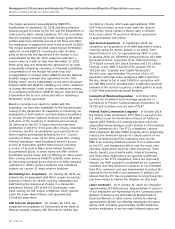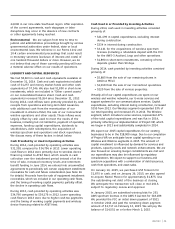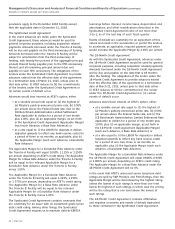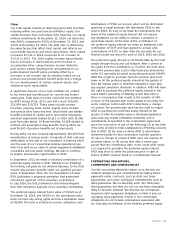AT&T Wireless 2014 Annual Report Download - page 25
Download and view the complete annual report
Please find page 25 of the 2014 AT&T Wireless annual report below. You can navigate through the pages in the report by either clicking on the pages listed below, or by using the keyword search tool below to find specific information within the annual report.
AT&T INC.
|
23
Spectrum In May 2014, the FCC issued an order revising
its policies governing mobile spectrum holdings. The FCC
rejected the imposition of caps on the amount of spectrum
any carrier could acquire, retaining its case-by-case review
policy. Moreover, it increased the amount of spectrum that
could be acquired before exceeding an aggregation “screen”
that would automatically trigger closer scrutiny of a
proposed transaction. On the other hand, it indicated that
it will separately consider an acquisition of “low band”
spectrum that exceeds one-third of the available low band
spectrum as presumptively harmful to competition. In
addition, the FCC imposed limits on certain bidders in the
600 MHz Auction, including AT&T, restricting them from
bidding on up to 40 percent of the available spectrum in
the incentive auction in markets that cover as much as
70-80 percent of the U.S. population. On balance, the order
and the new spectrum screen should allow AT&T to obtain
additional spectrum to meet our customers’ needs, but
because AT&T uses more “low band” spectrum in its
network than some other national carriers, the separate
consideration of low band spectrum acquisitions might
affect AT&T’s ability to expand capacity in these bands.
Also, a competitor has filed a petition asking the FCC to
increase the percentage of spectrum for which we would
be prohibited from bidding in the incentive auction. That
petition is pending. We seek to ensure that we have the
opportunity, through the auction process and otherwise,
to obtain the spectrum we need to provide our customers
with high-quality service in the future.
COMPETITION
Competition continues to increase for telecommunications
and information services. Technological advances have
expanded the types and uses of services and products
available. In addition, lack of or a reduced level of
regulation of comparable alternatives (e.g., cable, wireless
and VoIP providers) has lowered costs for these alternative
communications service providers. As a result, we face
heightened competition as well as some new opportunities
in significant portions of our business, including our 2015
acquisition of a Mexican wireless provider.
Wireless
We face substantial and increasing competition in all
aspects of our wireless business. Under current FCC rules,
multiple licensees, who provide wireless services on the
cellular, PCS, Advanced Wireless Services, 700 MHz and
other spectrum bands, may operate in each of our service
areas, which results in the potential presence of multiple
competitors. Our competitors include brands such as
Verizon Wireless, Sprint, T-Mobile/Metro PCS, a larger
number of regional providers of cellular, PCS and other
wireless communications services and resellers of those
services. In addition, we face competition from providers
of their service offerings. In addition, the rules prohibited
providers of fixed (but not mobile) broadband Internet
access service from unreasonably discriminating in their
transmission of lawful network traffic.
In its decision, the court found the FCC had authority under
section 706 of the Act (which directs the FCC and state
commissions to promote broadband deployment) to adopt
rules designed to preserve the open Internet, but vacated
and remanded the antidiscrimination and no-blocking rules
on the ground that they impermissibly imposed common
carrier regulation on broadband Internet access service.
The court held that, having declared broadband Internet
access services to be information services, the FCC could
not regulate them as telecommunications services.
The court did not vacate the transparency rules.
The court’s finding that section 706 provides the FCC
independent authority to adopt rules to promote broadband
deployment appears to give the FCC broad authority to
regulate the Internet and, more generally, IP-based
services, provided the FCC finds such regulation promotes
deployment of broadband infrastructure. In addition, because
section 706(a) grants authority to both the FCC and the
states to adopt rules to promote broadband deployment,
states could attempt to rely on that provision to regulate
broadband services, although the states’ authority to do so
appears to be narrower than the FCC’s. In May 2014, the
FCC released a notice of proposed rulemaking in response
to the D.C. Circuit’s January decision that also asks wide-
ranging questions that appear to re-open settled issues.
Importantly, the FCC asks whether it has sufficient authority
under section 706 to reestablish protections against
discrimination and blocking on broadband Internet access
services or whether it needs to reclassify broadband
Internet access service as a telecommunications service
to achieve its regulatory goals. In November 2014, the
president issued a statement urging the FCC to reclassify
both fixed and mobile consumer broadband Internet access
services as telecommunications services, subject to
comprehensive regulation under Title II of the Act. Although
the president also recommended that the FCC refrain from
rate regulation and other provisions less relevant to
broadband service, this proposal, if adopted and upheld,
would significantly expand the FCC’s existing authority
to regulate the provision of fixed and mobile broadband
Internet access services. The FCC now appears poised
to adopt this proposal, along with expanding the net
neutrality rules into mobile broadband Internet access
services. In addition, the FCC may assert jurisdiction over
Internet interconnection arrangements, which until now
have been unregulated. In addition, if the states were to
impose additional regulation and/or taxes on the Internet
or broadband services, it could have a material adverse
impact on our broadband services and operating results.




